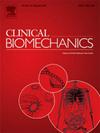Is suture-based cerclage biomechanically superior to traditional metallic cerclage for fixation of periprosthetic femoral fractures: A matched pair cadaveric study
IF 1.4
3区 医学
Q4 ENGINEERING, BIOMEDICAL
引用次数: 0
Abstract
Background
While traditional metallic cerclage remains the primary method in clinical application, non-metallic cerclage systems have recently gained popularity due to low risks of soft tissue irritation and bone intrusion. The objective of this study was to assess the performance of a novel non-metallic suture-based cerclage in comparison to traditional metallic cerclage cables for fixation of periprosthetic femoral fractures.
Methods
An extended trochanteric osteotomy was performed on eight pairs of cadaveric femora, followed by reduction using either metallic cerclages (Group I) or the suture-based cerclage (Group II). A modular tapered fluted stem was then implanted in each specimen. The fragment translation during canal preparation and stem implantation was quantified using laser-scanning. Subsequently, each specimen underwent 500 cycles of multiaxial loading, with fragment translation and stem subsidence measured using a motion capture system.
Findings
Following stem implantation, specimens in Group II exhibited a significantly greater lateral fragment translation (466 μm vs 754 μm, p = 0.017). However, there were no significant differences in anterior and distal translation between groups (p > 0.05). During multiaxial loading, the average stem subsidence in Group I was 0.36 mm (range, 0.04–1.42 mm), compared to 0.41 mm (range, 0.03–1.29) in Group II (p > 0.05). No significant difference was found in fragment translations between the two groups (p > 0.05).
Interpretation
The suture-based cerclage system exhibited comparable biomechanical performance in fixation stability to conventional metallic cerclage cables. Yet, it was associated with a larger residual lateral gap between the fragments following stem implantation. Ultimately, the choice of fixation method should account for multiple factors, including patient characteristics, surgeon preference, and bone quality.
在固定股骨假体周围骨折时,缝合式陶瓷包扎在生物力学上是否优于传统的金属陶瓷包扎:一项配对尸体研究。
背景:尽管传统的金属颅内固定仍是临床应用的主要方法,但非金属颅内固定系统因其对软组织刺激和骨侵入的风险较低而在近期受到欢迎。本研究的目的是评估一种新型非金属缝合型cerclage与传统金属cerclage钢缆在固定股骨假体周围骨折方面的性能比较:在八对尸体股骨上进行了股骨粗隆截骨术,然后使用金属铈环(I组)或缝合铈环(II组)进行复位。然后在每个标本中植入模块化锥形凹槽柄。使用激光扫描量化了牙槽预备和牙杆植入过程中的片段平移。随后,每个标本接受了500个周期的多轴加载,并使用运动捕捉系统测量了片段平移和骨干下沉:结果:植入骨干后,II组标本显示出明显更大的侧向片段平移(466 μm vs 754 μm,p = 0.017)。不过,各组之间的前移和远移没有明显差异(p > 0.05)。在多轴加载期间,I组的骨干平均下沉0.36毫米(范围:0.04-1.42毫米),而II组为0.41毫米(范围:0.03-1.29)(p > 0.05)。两组患者的骨折片移位无明显差异(P>0.05):解读:缝合线cerclage系统在固定稳定性方面的生物力学表现与传统金属cerclage电缆相当。解读:缝合式cerclage系统在固定稳定性方面的生物力学性能与传统的金属cerclage电缆相当,但在植入骨干后,碎片之间的残留侧向间隙较大。最终,固定方法的选择应考虑多种因素,包括患者特征、外科医生偏好和骨质。
本文章由计算机程序翻译,如有差异,请以英文原文为准。
求助全文
约1分钟内获得全文
求助全文
来源期刊

Clinical Biomechanics
医学-工程:生物医学
CiteScore
3.30
自引率
5.60%
发文量
189
审稿时长
12.3 weeks
期刊介绍:
Clinical Biomechanics is an international multidisciplinary journal of biomechanics with a focus on medical and clinical applications of new knowledge in the field.
The science of biomechanics helps explain the causes of cell, tissue, organ and body system disorders, and supports clinicians in the diagnosis, prognosis and evaluation of treatment methods and technologies. Clinical Biomechanics aims to strengthen the links between laboratory and clinic by publishing cutting-edge biomechanics research which helps to explain the causes of injury and disease, and which provides evidence contributing to improved clinical management.
A rigorous peer review system is employed and every attempt is made to process and publish top-quality papers promptly.
Clinical Biomechanics explores all facets of body system, organ, tissue and cell biomechanics, with an emphasis on medical and clinical applications of the basic science aspects. The role of basic science is therefore recognized in a medical or clinical context. The readership of the journal closely reflects its multi-disciplinary contents, being a balance of scientists, engineers and clinicians.
The contents are in the form of research papers, brief reports, review papers and correspondence, whilst special interest issues and supplements are published from time to time.
Disciplines covered include biomechanics and mechanobiology at all scales, bioengineering and use of tissue engineering and biomaterials for clinical applications, biophysics, as well as biomechanical aspects of medical robotics, ergonomics, physical and occupational therapeutics and rehabilitation.
 求助内容:
求助内容: 应助结果提醒方式:
应助结果提醒方式:


